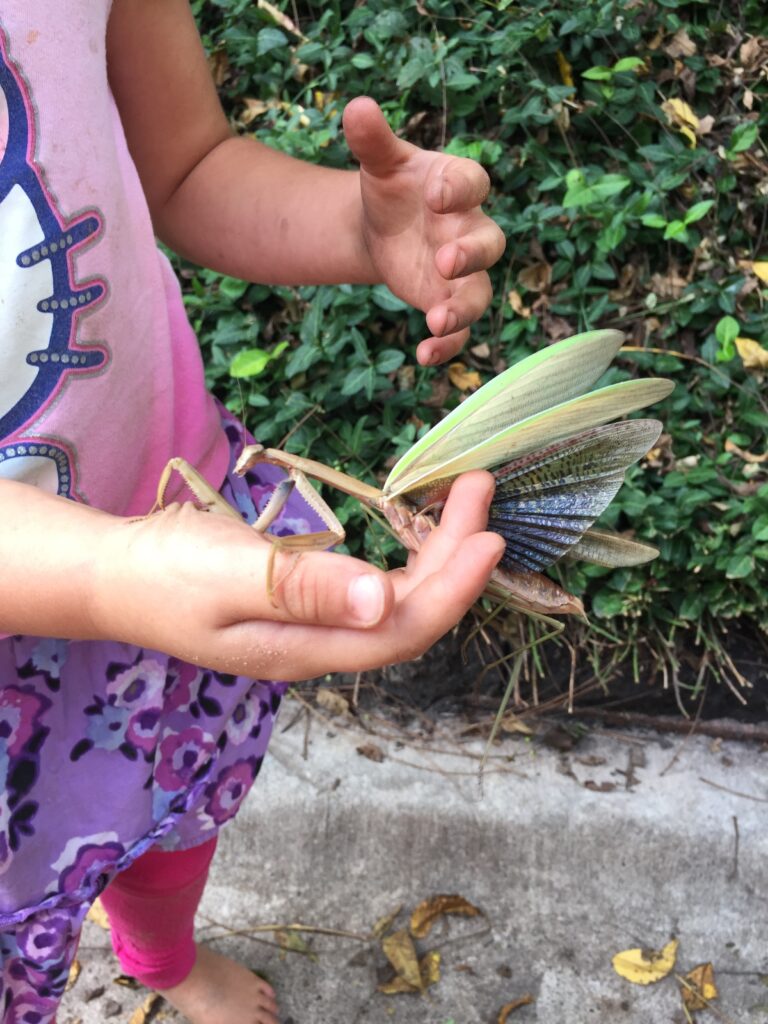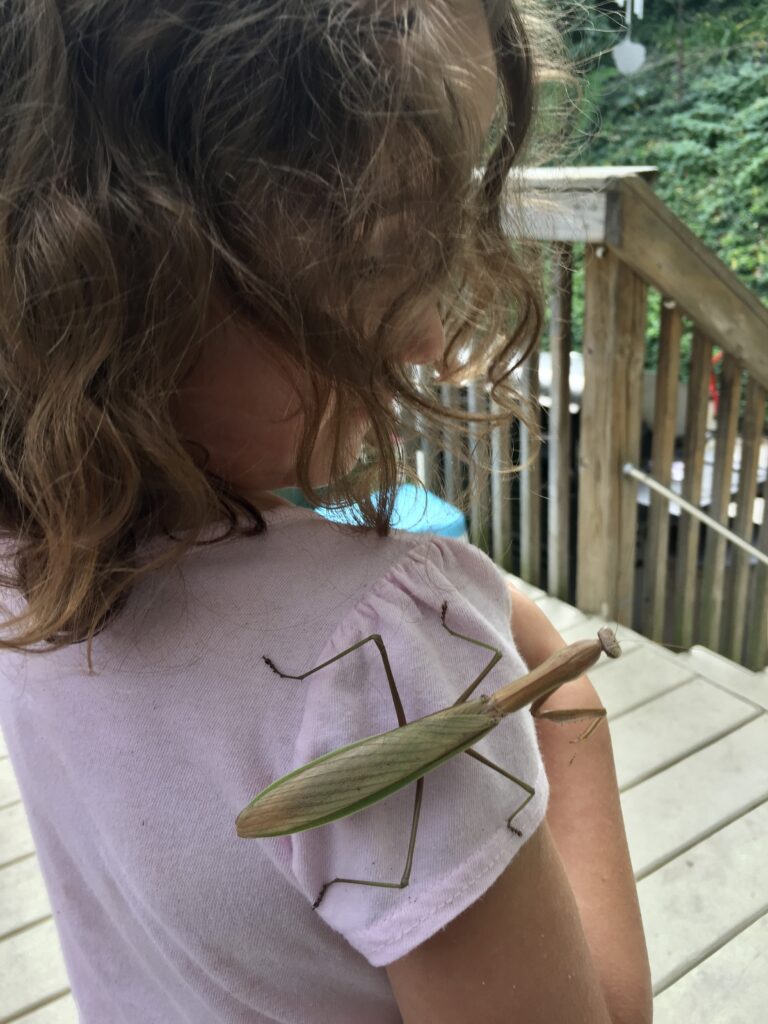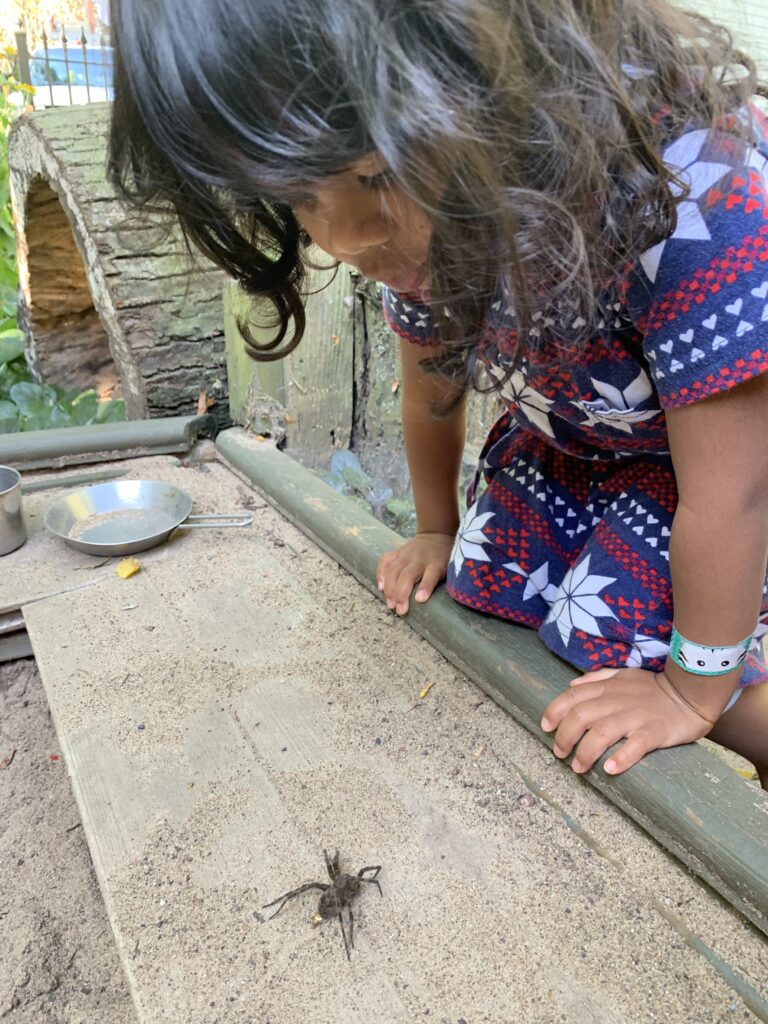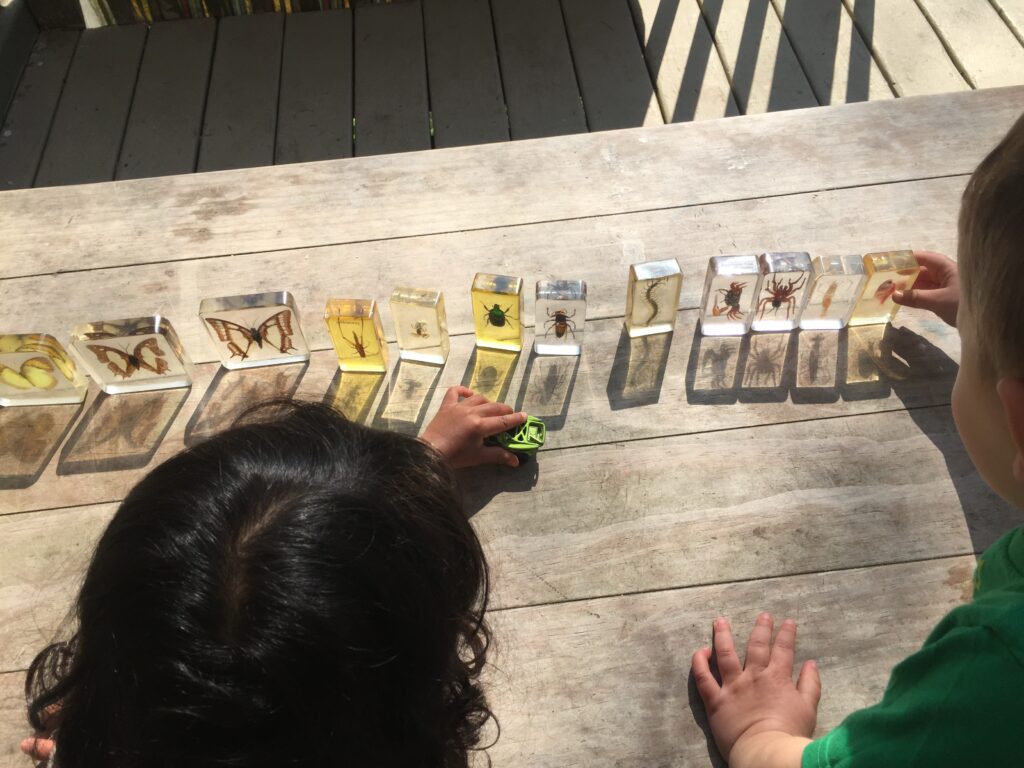Insect Adventures
“Look what I found!” yells Peter. “Rowan! Come quick! I think it’s a praying mantis!”
“Wow! It’s so big!” says Parker. “That can’t be a praying mantis, can it? Is it a grasshopper?”
Five-year-old Rowan comes running. Our class science expert and budding entomologist, Rowan really knows her insects. She’s the first person we turn to for all bug-related questions and insect investigations.
“Oh yes, that is a praying mantis,” Rowan confirms. “But it is a Chinese Praying Mantis. We usually find the smaller Carolina Praying Mantis.”

I watch as Rowan holds her hand out flat, encouraging the insect to venture onto her palm.
Rowan is magical with insects. They seem to know that she won’t hurt them. They trust her and she trusts them. She instills that curiosity and trust in the rest of us and leads our investigations while reminding us of the value of insects in our daily lives.
“You had a really good eye spotting this one, Parker,” says Rowan approvingly. “She was hard to see because her green, brown and gray colors match the colors of the leaves and twigs and dirt in the garden. She was probably looking for insects and spiders to eat.”
“Her wings are so big and so beautiful!” says Parker in wonderment. “I think she turned her head and looked at me. Can she do that?”
“She can!” confirms Rowan. “A praying mantis can turn its head just like a human. It’s the only insect that can do that, I think. Oh, and she will eat her brothers and sisters if she is really hungry!”

“Oh, yeah, just like in that book we read! Can we read it again?”
Parker is referring to one of our summer reading favorites—a book called My Awesome Summer by P. Mantis. The actual author, Paul Meisel, tells the story of the life cycle of a praying mantis in the form of a daily diary. Engaging and easy to understand, this beautifully illustrated book is always a hit with the under-five set. The author has also “ghostwritten” books by Stinky Bug, Blue Bird and Hummingbird, which are equally wonderful.

From walking sticks to luna moths, grasshoppers and bumblebees, our fascination with insects never ends. Children have an innate curiosity about the natural world, and I try to incorporate insects into our outdoor curriculum whenever possible.
Sometimes the biggest deterrents to our “entomology curriculum” are the parents who inadvertently sabotage our insect studies—from the“Screamer/Dasher” who swats, shouts and runs when one of our precious pollinators flies by to the dreaded “Squisher” who steps on the Daddy Long Legs that we’ve been observing all day long.
Because children are sponges, some enter our program with a fear of insects already embedded in their developing brains. We try to shift their perspectives from a fear-based belief such as “Bees will sting you” and teach them that bees are an important part of our ecosystem, pollinating our crops so that we have food to eat and gathering nectar from flowers to make honey.
We also try to dispel the “arachnophobia” that many parents have instilled in their children. We tell our young insect investigators that “Spiders don’t bite. They catch flies and make beautiful webs to catch other insects for their dinner.”
With so many fears to dispel, we’re thrilled to have a mentor like Rowan to lead the way!

By setting up an outdoor learning center, you can introduce your early learners to the wonders of the natural world as they spend hours engaged in exploration and discovery.
One of the best parts of outdoor learning is that many of your scientific investigations don’t need to be planned ahead of time. Let the children conduct their own investigations and learn at their own pace—fueled by their curiosity and their unique interests. This is early science and child-led learning at its best!
Here are a few ways to get started:
- Bring some science materials outside to create a “science center” in your outdoor play area.
- Place a basket of books about insects, birds and weather in your outdoor play space for easy access during your outdoor learning adventures.
- Don’t forget to include insect collection and observation tools such as bug catchers, magnifying glasses, insect viewing jars and a butterfly pavilion (we often use an Ikea hamper made of netting as our butterfly pavilion). Don’t forget a field guide to local insects and birds!
- We also take our acrylic/resin insect blocks outdoors. The children seem to play with these more when we move them outside. They’re a great way to introduce insects to young children, who seem to slow down and study the details more closely in the soothing environs of the natural world.
- Add plastic insects and snakes to your sand area to create habitats and encourage the children to observe the number of legs on the insects, where the eyes are located and other insect and snake characteristics.
- Add native plants and a rain garden to your outdoor space to create more learning opportunities. Check your village, city, county or state websites for rain barrel or rain garden programs that will reimburse you for a portion of the cost of setting up rain barrels to conserve water or creating a rain garden to absorb excess rainwater and prevent flooding.

“Is everyone done looking at the praying mantis?” asks Rowan. “I am going to put her back in her habitat now.”
Thirty minutes after the initial discovery, P. Mantis is returned to her home. This short amount of time gave each child a close-up view of a wondrous creature, along with a chance to hold the largest praying mantis that they had ever seen and learn a few fascinating insect facts that they can share with their families.
So set the stage with an outdoor learning center, invite the insects in and let the science come to you!
I like how the children’s first comment about the praying mantis wings are “big”.
Another interesting fact that interested me was when Parker was telling his friends about a praying mantis book that he read over the summertime.
At my daycare the children look at the spiders and ants. We have a bottle for bugs
children love to play outside and find bugs
I love teachers who are willing to teach about and explore spiders and bugs
great way for children to learn
What a great way to teach the children of where the bugs live
love the praying manits
Children will love the growth and
The life cycle of bugs are very interesting for adults and children alike. You could take any bug and examine its life cycle to enhance children’s exploration of them in growth and change.
Lamont Jackson
we did a study of insects .I was really against it, but by the end it was really fun for me and the kids
SO many opportunities for exploration of insects/bugs. Can do a compare/contrast activity between different ones. Discuss difference between insects and arachnids. Research different habitats of different insects. Study the life cycle of several. How are the different insects helpful?
I like the Vocabulary used with children! Excellent ideas! I like explaining to the Children that Insects are part of our Ecosystem!
great blog
I love how children had the opportunity to touch the insects
I love this activity , I will do it in my class room
Activities and I know that the kids really enjoy bags
I am going to try to take the children outside to find bugs and let them experience them crawling on them and learn about different kinds of insects in their legs and how many they have.
finding bugs is fun for some and a challenge for others who are afraid. It will be interesting
life cycle would be great
great
thank you
Enjoyed this activity. I will have to try with my children.
Helping children to respect living creatures is an important concept to teach. Not harming insects is a great way to encourage this concept!!
I love how their interest in the praying mantis lead to expanding their understanding of the life cycle of a praying mantis / so important to see where their interests lie and use it as a springboard to a science lesson!